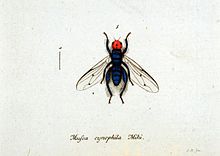Thyreophora cynophila
| Thyreophora cynophila | |
|---|---|

| |
| Thyreophora cynophila (Plate by Jacob Sturm) | |
| Scientific classification | |
| Kingdom: | |
| Phylum: | |
| Class: | |
| Order: | Diptera |
| Family: | |
| Subfamily: | |
| Tribe: | |
| Genus: | Thyreophora Meigen, 1803
|
| Species: | T. cynophila
|
| Binomial name | |
| Thyreophora cynophila (Panzer, 1798)
| |
| Synonyms | |
| |
Thyreophora cynophila, commonly known as the bone skipper[1] is a species of fly native to Europe. It was once thought to be the first fly to be driven to extinction by humans, but rediscovered in 2009.[1] It has a bright orange head, and is associated with animal carcasses where the bones are broken open.

Description
Thyreophora cynophila was originally described by
Extinction
The species was not recorded in the wild after 1850, and was long considered to be extinct.
Rediscovery
In late 2009, an amateur photographer took a photograph of a fly that he did not recognise in the
References
- ^ a b c Rowan Hooper (September 22, 2010). "Zoologger: Horror fly returns from the dead". New Scientist.
- ^ .
- ^ Matt Walker (September 17, 2010). "'Mythical' extinct fly rediscovered after 160 years". BBC News. Retrieved September 17, 2010.
- ^ PDF). Boletín de la Sociedad Entomológica Aragonesa (S.E.A.). 46: 1–7.
- PDF). Boletín de la Sociedad Entomológica Aragonesa (S.E.A.). 48: 403–405.
